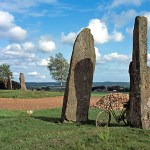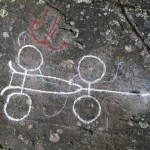Sweden's bedrock has been entirely abraded by the inland ice. It sanded down the country like a big wood planer, leaving smooth lovely outcrops known as hällar all over the place. This is the main natural prerequisite of Sweden's rich rock art tradition. Most of it dates from the Bronze Age, 1700–500 BC.
Denmark hardly has any visible bedrock, so they don't have much rock art over there, and what they do have tends to be on boulders. It is thus hardly surprising that when you do find figurative art on boulders in Sweden, it tends to be in the provinces closest to Denmark.
Near Asige church in…
rock art
Bronze Age rock art along Sweden's south-east coast is rich but not as varied as that of the famous west-coast region. One motif that we have been missing is the four-wheel wagon. It isn't common anywhere except on one site, Frännarp in inland Scania (below right), but we have had none whatsoever where I am.
Wagons at Frännarp in Scania
The other day we got our first wagon: at the rich classical site of Himmelstalund on the outskirts of Norrköping in Östergötland province. According to period convention, it is depicted in a flattened perspective with the wheels seen from the sides and the…
tags: Paleontology, birds, Genyornis newtoni, rock art, aboriginal peoples, Archaeology, Australia, Niwarla Gabarnmung, Arnhem Land, Flinders University
Australia's oldest painting?
A red ochre rock art depiction of two emu-like birds (Genyornis newtoni?)
with their necks outstretched.
Image: Ben Gunn [larger view]
An Australian Aboriginal rock art may depict a giant bird that is thought to have become extinct some 40,000 years ago, thereby making it the oldest rock painting on the island continent. The red ochre drawing was first discovered two years ago, but archaeologists were only…

